Aim: Find a couple of contemporary printmakers whose work you like, and reflect on their techniques. How do they use lino? What sort of marks do they make? What could you learn from them?
Hannah Hoch (1889-1978)
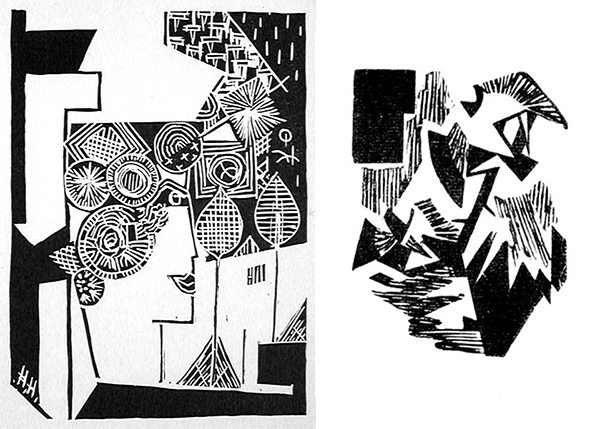 Above left: Cleopatra, 1970 linoprint. Right: Kommen flatternde Vogel, c. 1915 linoprint.
Above left: Cleopatra, 1970 linoprint. Right: Kommen flatternde Vogel, c. 1915 linoprint.
Cleopatra encompasses both large cut-away areas and precise fine lines in selected areas, which one would think gives both interest and balance. Hoch has left most of the lino edging in place, providing a definite border to the work, and my eye is kept within the piece. However, I’m really not convinced about the large unprinted sections and the split between positive and negative space seems roughly 50%. The subject is intriguing, with complex patterning, and she has managed some very narrow print lines obviously using fine cutting tools.
Kommen flatternde Vogel (Come fluttering bird) portrays just the idea of a hovering or quivering bird. Again the line work is fine and precisely directional and successfully gives the impression of fluttering wings and tail. Most of the edging has been cut away, which makes it difficult to print as the inked roller can easily slip into the lower, carved areas and accidentally leave ink marks which can be picked up on the paper. Again, a lot of negative space has been left but it seems to feel more balanced. Perhaps it is because the shapes are quite tightly packed with most unprinted sections being on the outer surround.
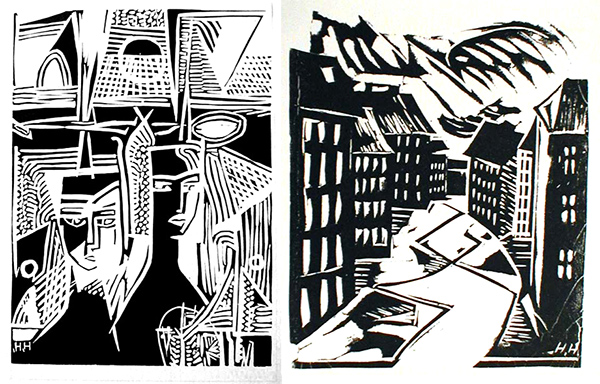 Above left: Zwei Madchen, 1970. Right: Street in Berlin, 1912.
Above left: Zwei Madchen, 1970. Right: Street in Berlin, 1912.
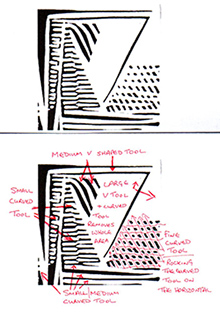 Zwei Madchen (Two Girls) includes many cutting techniques. I’ve done an analysis on a small section (left), listing which cutters I believe were used.
Zwei Madchen (Two Girls) includes many cutting techniques. I’ve done an analysis on a small section (left), listing which cutters I believe were used.
We can see some very definite graphic imagery of the two girls mixed with substantial abstract patterning. I haven’t managed to find an explanation of what this is supposed to represent, but I enjoy it anyway without this knowledge.
It leaves me wondering: Are these window reflections or abstracted scenery such as buildings and maybe a church in the top left section? Or is it all just a figment of the artists imagination?
Street in Berlin is my favourite of the works shown here. To me it represents a stormy and ominous night, water slick on the ground throwing reflections from the buildings and lightning across the hard ground, all adding to the grim starkness. All it needs is the addition of Philippe Marlowe lurking in a darkened doorway to translate it into an advertisement for a Raymond Chandler novel.
Bold and uneven strokes in the top third of the composition have created drama and intensity. The sharp points of the remaining lino in this area adds to the effect and forces the viewer to imagine dark rain laden stormy clouds. Even the ‘approximate’ cutting of lino to make windows has been carefully planned to show areas of light and shade, and each has been removed with a flick from a curved cutter. Very clever.
As the bulk of the buildings have been left to print, we are presented with an artwork which has a predominance of black, giving a somewhat forbidding impression.
I’m particularly impressed with the perspective and the rising ground (is it actually ground?) as it twists through the street. So, do you see what I see, or is at all just my imagination? Whatever the answer, the artist has produced a well carved art piece that engages the audience and certainly makes me think.
Arone Raymond Meeks (1957-)
From Laura, Far North Queensland, Meeks belongs to the Kuku Midigi tribe (he is also credited with being a Murrie tribesman on other sites) and he currently resides in Cairns. His art training has been both traditional and formal, including studying at the City Art Institute in Sydney and other institutes in Queensland, then spending time with tribal elders in Queensland working with his own and other tribal influences. His art is widely collected internationally.
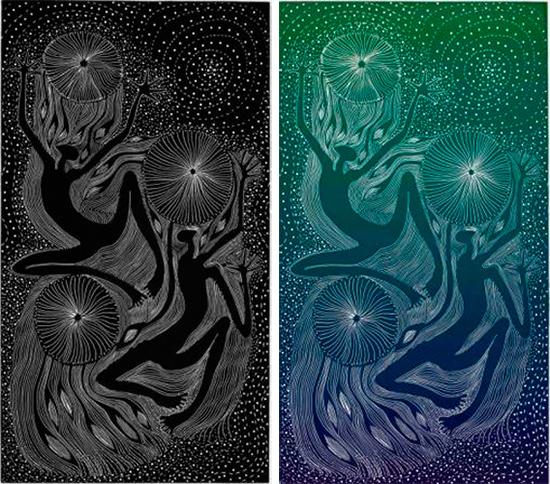 Above left: Irukandji Season ll, no date specified. Right: Irukandji Season, no date specified.
Above left: Irukandji Season ll, no date specified. Right: Irukandji Season, no date specified.
So, who believes that you can’t carve away areas of lino leaving very fine printable lines?
These lino-cuts demonstrate incredible expertise in cutting techniques. Firstly there are the solid silhouette human – or more likely spirit – forms, seemingly interacting with the Irukandji (which is a seriously dangerous thing to do – see note below*). Then the Irukandji themselves, almost entirely carved away but still a major presence. The swirling water around the figures consists of hundreds of very, very fine carved lines, surely with a .5mm cutter, so close-set as to almost merge. On the outer areas we see the more traditional line and dot work that Aboriginals are naturally associated with. But look at those dots, they ARE dots not an approximation or a rough cut speck. Could they be made using the same .5mm tool, standing on its end whilst being carefully twisted to carve these tiny accurate shapes?
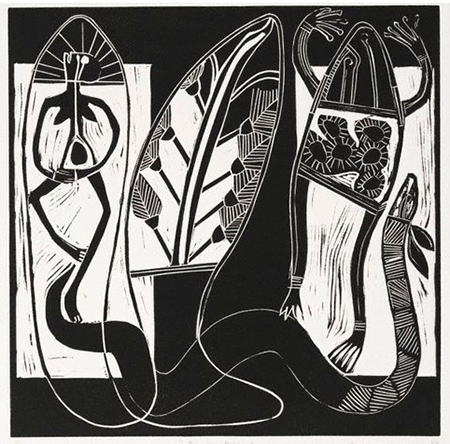 Above: Dilly bag, 1987, No. 11 from edition of 15.
Above: Dilly bag, 1987, No. 11 from edition of 15.
In Dilly bag Meeks has produced a print with well-balanced positive and negative space. The imagery, likely depicting a tribal story, is clear and well-defined. Those of us who look fairly regularly at Aboriginal art are familiar with serpents and other stylised animals and flora, along with the stick-like figures of humans and / or spirits. The ‘interference’ evident throughout some of the solidly carved areas has added to the overall work and erased any feeling of too much white being exposed and the print becoming ‘sterile’.
He has cleverly carved thin lines, in both positive and negative, and added fine detail to the serpent head and part body using a very fine tool. The background line work is very accurately straight (top and bottom of large white areas) and I suspect he used a flat blade to cut into the lino first to create a sharp edge for the lino cutters to run along. I recently read a very interesting article on this cutting style and will try it out on my next prints.
The side outlines of the background are less straight and I believe the cutter was rocked a little as it was moved through the lino. That technique creates a bit of an undulating line but with no sharp edges. Where there are wider lines of removed lino he will have used a medium curved tool, so achieving rounded ends where the cutter has entered and exited the lino (note centre cut vein of leaf shape).
So what have I learned from these two artists?
I can’t put my finger on one specific aspect. However, it has shown me excellent examples of combinations of imagery formed through using multiple tools, thereby altering the print density in selected areas. I’ve also seen how moods and emotions can be formed through smart placement of two colours – well, one print colour and the background.
This exercise reminds me that I’m just a beginner but that my cutting so far hasn’t been too bad.
Note: Tutor feedback from Assignment 1 suggested that I might like to explore the linocuts of Kathe Kollwitz (1867-1945) during this section. However, after an extensive search including MOMA, the Kathe Kollwitz Museum Berlin, Ro Gallery and others, I’ve been unable to locate any such works. All those I thought may be possibilities were in fact woodcuts.
Resources:
Hannah Hoch – http://www.spaightwoodgalleries.com/Pages/Hoch.html
Arone Meeks – http://www.aboriginalartonline.com/art/meeks.php
http://www.artgallery.nsw.gov.au/collection/works/?artist_id=meeks-arone
http://www.artgallery.nsw.gov.au/collection/works/14.1988/
http://www.thegalleryeumundi.com.au/index.php?main_page=index&cPath=7_2
*Irukandji definition: The Irukandji jellyfish is believed to be the most venomous creature in the world. It is around 2.5cm in diameter (with bell and tentacles), which makes it very hard to spot. The term Irukandji refers to an Australian Aboriginal tribe that inhabited the Palm Cove region of northern Queensland where Irukandji syndrome, produced by the poisoned stings of the jellyfish, most often occurs. http://www.irukandjijellyfish.com
